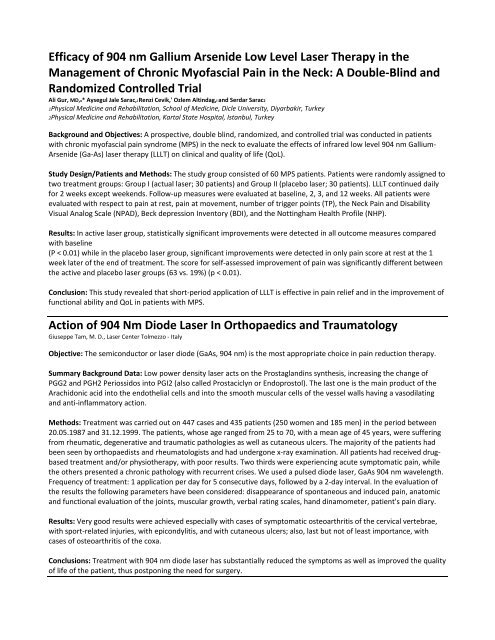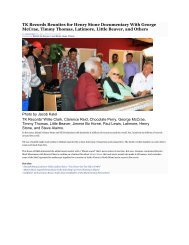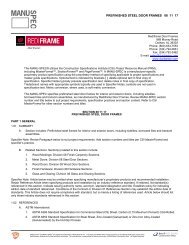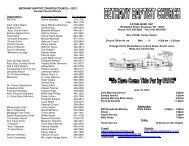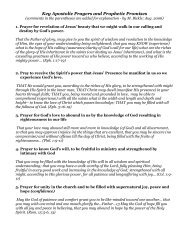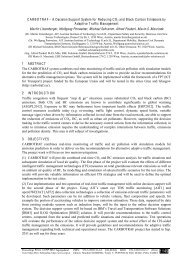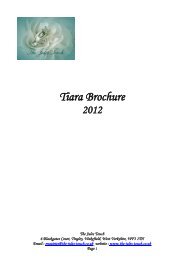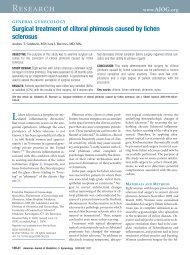Efficacy of 904 nm Gallium Arsenide Low Level Laser Therapy in the ...
Efficacy of 904 nm Gallium Arsenide Low Level Laser Therapy in the ...
Efficacy of 904 nm Gallium Arsenide Low Level Laser Therapy in the ...
Create successful ePaper yourself
Turn your PDF publications into a flip-book with our unique Google optimized e-Paper software.
<strong>Efficacy</strong> <strong>of</strong> <strong>904</strong> <strong>nm</strong> <strong>Gallium</strong> <strong>Arsenide</strong> <strong>Low</strong> <strong>Level</strong> <strong>Laser</strong> <strong>Therapy</strong> <strong>in</strong> <strong>the</strong><br />
Management <strong>of</strong> Chronic My<strong>of</strong>ascial Pa<strong>in</strong> <strong>in</strong> <strong>the</strong> Neck: A Double‐Bl<strong>in</strong>d and<br />
Randomized Controlled Trial<br />
Ali Gur, MD,x* Aysegul Jale Sarac,i Renzi Cevik,' Ozlem Alt<strong>in</strong>dag,l and Serdar Sarac2<br />
1Physical Medic<strong>in</strong>e and Rehabilitation, School <strong>of</strong> Medic<strong>in</strong>e, Dicle University, Diyarbakir, Turkey<br />
2Physical Medic<strong>in</strong>e and Rehabilitation, Kartal State Hospital, Istanbul, Turkey<br />
Background and Objectives: A prospective, double bl<strong>in</strong>d, randomized, and controlled trial was conducted <strong>in</strong> patients<br />
with chronic my<strong>of</strong>ascial pa<strong>in</strong> syndrome (MPS) <strong>in</strong> <strong>the</strong> neck to evaluate <strong>the</strong> effects <strong>of</strong> <strong>in</strong>frared low level <strong>904</strong> <strong>nm</strong> <strong>Gallium</strong>‐<br />
<strong>Arsenide</strong> (Ga‐As) laser <strong>the</strong>rapy (LLLT) on cl<strong>in</strong>ical and quality <strong>of</strong> life (QoL).<br />
Study Design/Patients and Methods: The study group consisted <strong>of</strong> 60 MPS patients. Patients were randomly assigned to<br />
two treatment groups: Group I (actual laser; 30 patients) and Group II (placebo laser; 30 patients). LLLT cont<strong>in</strong>ued daily<br />
for 2 weeks except weekends. Follow‐up measures were evaluated at basel<strong>in</strong>e, 2, 3, and 12 weeks. All patients were<br />
evaluated with respect to pa<strong>in</strong> at rest, pa<strong>in</strong> at movement, number <strong>of</strong> trigger po<strong>in</strong>ts (TP), <strong>the</strong> Neck Pa<strong>in</strong> and Disability<br />
Visual Analog Scale (NPAD), Beck depression Inventory (BDI), and <strong>the</strong> Nott<strong>in</strong>gham Health Pr<strong>of</strong>ile (NHP).<br />
Results: In active laser group, statistically significant improvements were detected <strong>in</strong> all outcome measures compared<br />
with basel<strong>in</strong>e<br />
(P < 0.01) while <strong>in</strong> <strong>the</strong> placebo laser group, significant improvements were detected <strong>in</strong> only pa<strong>in</strong> score at rest at <strong>the</strong> 1<br />
week later <strong>of</strong> <strong>the</strong> end <strong>of</strong> treatment. The score for self‐assessed improvement <strong>of</strong> pa<strong>in</strong> was significantly different between<br />
<strong>the</strong> active and placebo laser groups (63 vs. 19%) (p < 0.01).<br />
Conclusion: This study revealed that short‐period application <strong>of</strong> LLLT is effective <strong>in</strong> pa<strong>in</strong> relief and <strong>in</strong> <strong>the</strong> improvement <strong>of</strong><br />
functional ability and QoL <strong>in</strong> patients with MPS.<br />
Action <strong>of</strong> <strong>904</strong> Nm Diode <strong>Laser</strong> In Orthopaedics and Traumatology<br />
Giuseppe Tam, M. D., <strong>Laser</strong> Center Tolmezzo ‐ Italy<br />
Objective: The semiconductor or laser diode (GaAs, <strong>904</strong> <strong>nm</strong>) is <strong>the</strong> most appropriate choice <strong>in</strong> pa<strong>in</strong> reduction <strong>the</strong>rapy.<br />
Summary Background Data: <strong>Low</strong> power density laser acts on <strong>the</strong> Prostagland<strong>in</strong>s syn<strong>the</strong>sis, <strong>in</strong>creas<strong>in</strong>g <strong>the</strong> change <strong>of</strong><br />
PGG2 and PGH2 Periossidos <strong>in</strong>to PGI2 (also called Prostaciclyn or Endoprostol). The last one is <strong>the</strong> ma<strong>in</strong> product <strong>of</strong> <strong>the</strong><br />
Arachidonic acid <strong>in</strong>to <strong>the</strong> endo<strong>the</strong>lial cells and <strong>in</strong>to <strong>the</strong> smooth muscular cells <strong>of</strong> <strong>the</strong> vessel walls hav<strong>in</strong>g a vasodilat<strong>in</strong>g<br />
and anti‐<strong>in</strong>flammatory action.<br />
Methods: Treatment was carried out on 447 cases and 435 patients (250 women and 185 men) <strong>in</strong> <strong>the</strong> period between<br />
20.05.1987 and 31.12.1999. The patients, whose age ranged from 25 to 70, with a mean age <strong>of</strong> 45 years, were suffer<strong>in</strong>g<br />
from rheumatic, degenerative and traumatic pathologies as well as cutaneous ulcers. The majority <strong>of</strong> <strong>the</strong> patients had<br />
been seen by orthopaedists and rheumatologists and had undergone x‐ray exam<strong>in</strong>ation. All patients had received drug‐<br />
based treatment and/or physio<strong>the</strong>rapy, with poor results. Two thirds were experienc<strong>in</strong>g acute symptomatic pa<strong>in</strong>, while<br />
<strong>the</strong> o<strong>the</strong>rs presented a chronic pathology with recurrent crises. We used a pulsed diode laser, GaAs <strong>904</strong> <strong>nm</strong> wavelength.<br />
Frequency <strong>of</strong> treatment: 1 application per day for 5 consecutive days, followed by a 2‐day <strong>in</strong>terval. In <strong>the</strong> evaluation <strong>of</strong><br />
<strong>the</strong> results <strong>the</strong> follow<strong>in</strong>g parameters have been considered: disappearance <strong>of</strong> spontaneous and <strong>in</strong>duced pa<strong>in</strong>, anatomic<br />
and functional evaluation <strong>of</strong> <strong>the</strong> jo<strong>in</strong>ts, muscular growth, verbal rat<strong>in</strong>g scales, hand d<strong>in</strong>amometer, patient's pa<strong>in</strong> diary.<br />
Results: Very good results were achieved especially with cases <strong>of</strong> symptomatic osteoarthritis <strong>of</strong> <strong>the</strong> cervical vertebrae,<br />
with sport‐related <strong>in</strong>juries, with epicondylitis, and with cutaneous ulcers; also, last but not <strong>of</strong> least importance, with<br />
cases <strong>of</strong> osteoarthritis <strong>of</strong> <strong>the</strong> coxa.<br />
Conclusions: Treatment with <strong>904</strong> <strong>nm</strong> diode laser has substantially reduced <strong>the</strong> symptoms as well as improved <strong>the</strong> quality<br />
<strong>of</strong> life <strong>of</strong> <strong>the</strong> patient, thus postpon<strong>in</strong>g <strong>the</strong> need for surgery.
Effects <strong>of</strong> <strong>904</strong>‐Nm <strong>Low</strong>‐<strong>Level</strong> <strong>Laser</strong> <strong>Therapy</strong> <strong>in</strong> <strong>the</strong> Management <strong>of</strong> Lateral<br />
Epicondylitis: A Randomized Controlled Trial.<br />
Lam LK, Che<strong>in</strong>g GL., Physio<strong>the</strong>rapy Department, Queen Elizabeth Hospital, Hong Kong.<br />
Objective: The aim <strong>of</strong> this study was to evaluate <strong>the</strong> effectiveness <strong>of</strong> <strong>904</strong>‐<strong>nm</strong> low‐level laser <strong>the</strong>rapy (LLLT) <strong>in</strong> <strong>the</strong><br />
management <strong>of</strong> lateral epicondylitis.<br />
Background Data: Lateral epicondylitis is characterized by pa<strong>in</strong> and tenderness over <strong>the</strong> lateral elbow, which may also<br />
result <strong>in</strong> reduction <strong>in</strong> grip strength and impairment <strong>in</strong> physical function. LLLT has been shown effective <strong>in</strong> its <strong>the</strong>rapeutic<br />
effects <strong>in</strong> tissue heal<strong>in</strong>g and pa<strong>in</strong> control.<br />
Methods: Thirty‐n<strong>in</strong>e patients with lateral epicondylitis were randomly assigned to receive ei<strong>the</strong>r active laser with an<br />
energy dose <strong>of</strong> 0.275 J per tender po<strong>in</strong>t (laser group) or sham irradiation (placebo group) for a total <strong>of</strong> n<strong>in</strong>e sessions. The<br />
outcome measures were mechanical pa<strong>in</strong> threshold, maximum grip strength, level <strong>of</strong> pa<strong>in</strong> at maximum grip strength as<br />
measured by <strong>the</strong> Visual Analogue Scale (VAS) and <strong>the</strong> subjective rat<strong>in</strong>g <strong>of</strong> physical function with Disabilities <strong>of</strong> <strong>the</strong> Arm,<br />
Shoulder and Hand (DASH) questionnaire.<br />
Results: Significantly greater improvements were shown <strong>in</strong> all outcome measures with <strong>the</strong> laser group than with <strong>the</strong><br />
placebo group (p < 0.0125), except <strong>in</strong> <strong>the</strong> two subsections <strong>of</strong> DASH.<br />
Conclusion: This study revealed that LLLT <strong>in</strong> addition to exercise is effective <strong>in</strong> reliev<strong>in</strong>g pa<strong>in</strong>, and <strong>in</strong> improv<strong>in</strong>g <strong>the</strong> grip<br />
strength and subjective rat<strong>in</strong>g <strong>of</strong> physical function <strong>of</strong> patients with lateral epicondylitis.<br />
Acute Cervical Pa<strong>in</strong> is Relieved with <strong>Gallium</strong> <strong>Arsenide</strong> (GaAs) <strong>Laser</strong><br />
radiation: A Double Bl<strong>in</strong>d Prelim<strong>in</strong>ary Study<br />
Fernando A Soriano, Roxana Rios, Miguel Pedrola, Jaquelel<strong>in</strong>a Giagnorio and Carlos R Battagliotti 1<br />
1<br />
The Second Ca<strong>the</strong>dra <strong>of</strong> Internal and Therapeutic Medic<strong>in</strong>e, Teach<strong>in</strong>g Hospital Eva Peron, National University <strong>of</strong> Rosario School <strong>of</strong> Medic<strong>in</strong>e, Rosario,<br />
Argent<strong>in</strong>a<br />
Study Design/Patients and Methods: Seventy‐one patients with acute cervical pa<strong>in</strong> were randomized <strong>in</strong> two groups.<br />
Group A, 37 patients were irradiated with a pulsed GaAs diode laser, <strong>904</strong> <strong>nm</strong>, pulse width 200 nsec, pulse frequency<br />
10,000 Hz, peak power <strong>of</strong> 20 W, average power 40 mW, spot size 150 um 2 <strong>in</strong> area (<strong>in</strong>cident power density <strong>of</strong><br />
approximately 26 W/cm 2 ) and an angle <strong>of</strong> divergence <strong>of</strong> 6 o . The laser was applied <strong>in</strong> <strong>the</strong> po<strong>in</strong>t technique with a dose <strong>of</strong> 4<br />
J/cm 2 per po<strong>in</strong>t <strong>in</strong> <strong>the</strong> area <strong>of</strong> pa<strong>in</strong>. Group B, 34 patients, was treated with sham irradiation with a deactivated laser<br />
system. Nei<strong>the</strong>r <strong>the</strong> patients nor <strong>the</strong> operator knew which group each patient was randomly assigned to. The use <strong>of</strong><br />
analgesic drugs and physical <strong>the</strong>rapy was excluded <strong>in</strong> both groups. Pa<strong>in</strong> was evaluated through a l<strong>in</strong>ear colour scale.<br />
<strong>Laser</strong> treatment was considered effective when pa<strong>in</strong> relief was more than 60%.<br />
Results: The treatment was effective <strong>in</strong> 94.59% <strong>of</strong> patients <strong>in</strong> group A and 38.24% <strong>of</strong> group B (p < 0.0019). The pa<strong>in</strong> was<br />
relieved completely <strong>in</strong> 67.56% <strong>of</strong> patients <strong>in</strong> group A and <strong>in</strong> 17.65% <strong>in</strong> group B. In patients <strong>in</strong> whom <strong>the</strong> response to <strong>the</strong><br />
treatment was effective, <strong>the</strong> pa<strong>in</strong> returned <strong>in</strong> <strong>the</strong> six months follow<strong>in</strong>g treatment <strong>in</strong> 14.28% <strong>of</strong> Group A, but <strong>in</strong> 58.33% <strong>of</strong><br />
group B (p < 0.005). No side effects were observed.<br />
Conclusion: These results suggest that GaAs laser radiation is an efficient and safe treatment for patients with acute<br />
cervical pa<strong>in</strong>. Six years have passed s<strong>in</strong>ce we <strong>in</strong>corporated <strong>the</strong> GaAs laser <strong>in</strong>to our <strong>the</strong>rapeutic arsenal and up to date we<br />
have irradiated more than two thousand patients with different k<strong>in</strong>ds <strong>of</strong> pa<strong>in</strong> and pa<strong>in</strong> sites. The aim <strong>of</strong> this work is to<br />
evaluate <strong>the</strong> real <strong>the</strong>rapeutic effect versus <strong>the</strong> placebo effect <strong>of</strong> laser <strong>the</strong>rapy <strong>in</strong> patients with acute cervical pa<strong>in</strong> <strong>in</strong> both<br />
<strong>the</strong> immediate effect and <strong>the</strong> possible latency <strong>of</strong> <strong>the</strong> pa<strong>in</strong> relief with LLLT.
<strong>Efficacy</strong> <strong>of</strong> <strong>Low</strong> Power <strong>Laser</strong> <strong>Therapy</strong> <strong>in</strong> Fibromyalgia: A S<strong>in</strong>gle‐Bl<strong>in</strong>d,<br />
Placebo‐Controlled Trial<br />
Gur, M. Karakoc, K. Nas, R. Cevik, J. Sarac and E. Demir<br />
Physical Medic<strong>in</strong>e and Rehabilitation, School <strong>of</strong> Medic<strong>in</strong>e, Dicle University, Diyarbakir, Turkey<br />
Objective: The aim <strong>of</strong> this study was to evaluate <strong>the</strong> effectiveness <strong>of</strong> <strong>904</strong>‐<strong>nm</strong> low‐level laser <strong>the</strong>rapy (LLLT) <strong>in</strong> <strong>the</strong><br />
management <strong>of</strong> fibromyalgia.<br />
Background: <strong>Low</strong> energy lasers are widely used to treat a variety <strong>of</strong> musculoskeletal conditions <strong>in</strong>clud<strong>in</strong>g fibromyalgia,<br />
despite <strong>the</strong> lack <strong>of</strong> scientific evidence to support its efficacy.<br />
Methods: A randomised, s<strong>in</strong>gle‐bl<strong>in</strong>d, placebo‐controlled study was conducted to evaluate <strong>the</strong> efficacy <strong>of</strong> low‐energy<br />
laser <strong>the</strong>rapy <strong>in</strong> 40 female patients with fibromyalgia. Patients with fibromyalgia were randomly allocated to active (Ga‐<br />
As) laser or placebo laser treatment daily for two weeks except weekends. Both laser and placebo laser groups were<br />
evaluated for <strong>the</strong> improvement <strong>in</strong> pa<strong>in</strong>, number <strong>of</strong> tender po<strong>in</strong>ts, sk<strong>in</strong>fold tenderness, stiffness, sleep disturbance,<br />
fatigue, and muscular spasm.<br />
Results: In both groups, significant improvements were achieved <strong>in</strong> all parameters (p0.05). It was found that <strong>the</strong>re was no significant difference<br />
between <strong>the</strong> two groups with respect to all parameters before <strong>the</strong>rapy whereas a significant difference was observed <strong>in</strong><br />
parameters as pa<strong>in</strong>, muscle spasm, morn<strong>in</strong>g stiffness and tender po<strong>in</strong>t numbers <strong>in</strong> favour <strong>of</strong> laser group after <strong>the</strong>rapy<br />
(p


